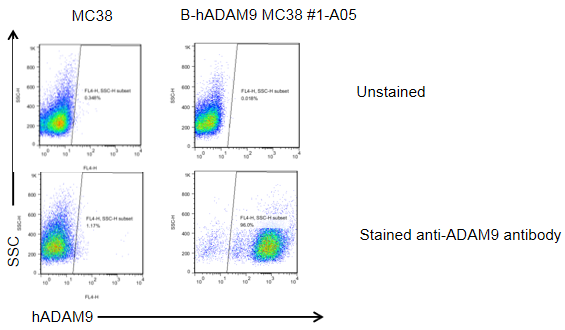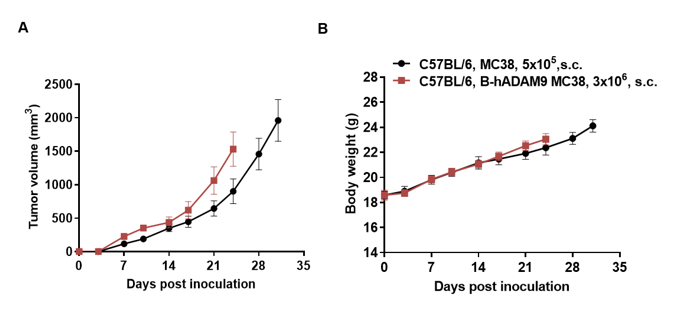B-hADAM9 MC38
|
Common name |
B-hADAM9 MC38 | Catalog number | 322015 |
| Aliases |
CORD9, MCMP, MDC9, Mltng |
Disease | Colon carcinoma |
|
Organism |
Mouse |
Strain | C57BL/6 |
| Tissue types | Colon | Tissue | Colon |
The exogenous promoter and chimeric ADAM9 coding sequence containing human extracellular domain, mouse transmembrane domain and cytoplasmic domain was inserted to replace murine exon 5-6.

Gene targeting strategy for B-hADAM9 MC38 cells. The exogenous promoter and chimeric ADAM9 coding sequence containing human extracellular domain, mouse transmembrane domain and cytoplasmic domain were inserted to replace murine exons 5-6. The insertion disrupts the endogenous murine ADAM9 gene, resulting in a non-functional transcript.

ADAM9 expression analysis in B-hADAM9 MC38 cells by flow cytometry. Single cell suspensions from wild-type MC38 and B-hADAM9 MC38 cultures were stained with species-specific anti-ADAM9 antibody. Human ADAM9 was detected on the surface of B-hADAM9 MC38 cells but not wild-type MC38 cells. The 1-A05 clone of B-hADAM9 MC38 cells was used for in vivo experiments.

Subcutaneous homograft tumor growth of B-hADAM9 MC38 cells. B-hADAM9 MC38 cells (3x106) and wild-type MC38 cells (5x105) were subcutaneously implanted into C57BL/6 mice (female, 6-week-old, n=6). Tumor volume and body weight were measured twice a week. (A) Average tumor volume ± SEM. (B) Body weight (Mean± SEM). Volume was expressed in mm3 using the formula: V=0.5 X long diameter X short diameter2. As shown in panel A, B-hADAM9 MC38 cells were able to establish tumors in vivo and can be used for efficacy studies.











